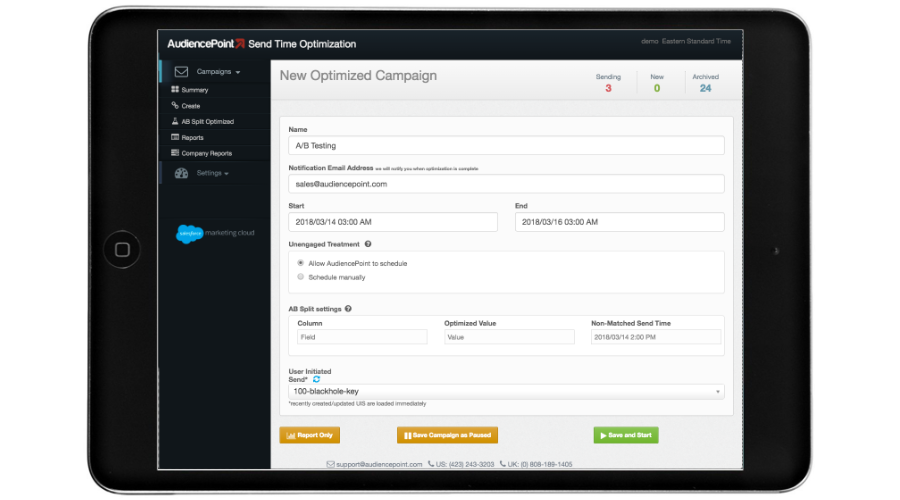AudiencePoint is thrilled to announce our new integration with Klaviyo! AudiencePoint is looking for partners to pilot our...
What Are Email Drip Campaign Examples?
Email drip campaigns are a sequence of automated, pre-written emails sent to potential customers over a set period as part of a broader email marketing strategy. These emails are usually triggered based on specific actions by the user, such as subscribing to a newsletter or abandoning a shopping cart. The primary aim is to nurture leads through the sales funnel by providing them with timely and relevant information.
Define an Email Drip Campaign
An email drip campaign involves setting up a series of emails that are sent out automatically at scheduled intervals. These campaigns are designed to nurture relationships, introduce products or services, and guide the recipient toward a specific action, such as making a purchase or completing a survey. The key element here is automation, ensuring that every potential lead gets the same experience without manual intervention.
Examples of Effective Email Drip Campaigns
Consider a new subscriber who signs up for a webinar. An effective email drip campaign might send an initial confirmation email followed by a series of educational emails leading up to the event. Post-webinar, a thank-you email might include links to additional resources and a survey for feedback. Another common example is the onboarding series for new users of a software product. This campaign might begin with a welcome email, followed by a series of tips, tutorials, and feature highlights to help the user get started effectively.
Use Cases in Different Industries, Such as Real Estate
The real estate sector can greatly benefit from drip campaigns. Real estate agents can use email drips to stay in touch with potential buyers by sending them property listings, market news, and mortgage advice at regular intervals. This ensures that the agent remains top-of-mind, making it more likely that the buyer will reach out when ready to purchase. For instance, a sequence might start with a welcome email and then follow up with weekly emails featuring new property listings that match the recipient’s criteria.
Overall, drip campaigns are an invaluable tool for maintaining engagement and nurturing leads across various industries.
What Is The Difference Between An Email Campaign And A Drip Campaign?
In the realm of email marketing, understanding the distinct differences between standard email campaigns and drip campaigns is crucial for strategizing effectively. While both are used to engage and convert audiences, their structure, execution, and goals often differ.
Standard Email Campaigns
A standard email campaign refers to a one-time set of emails sent to a targeted list of recipients. These could be newsletters, promotional offers, or announcements. The primary goal is usually to impart key information or drive immediate actions, such as promotions or time-sensitive offers. The emails are generally sent to the entire list simultaneously and focus on short-term objectives.
Drip Campaigns
In contrast, a drip campaign consists of a series of pre-written emails sent out at predetermined intervals. The idea is to gradually ‘drip’ information and content to the recipients over time, which can help nurture leads through the buyer’s journey. These campaigns are highly automated and personalized based on the recipient’s past actions or data.
Types of Drip Campaigns
Multiple types of drip campaigns exist, each designed to achieve specific goals. For example, a ‘welcome series’ drip campaign introduces new subscribers to your brand. ‘Nurture campaigns’ are another variety that involves guiding leads through the sales funnel by providing relevant content at various stages of their journey.
Customer re-engagement campaigns target inactive subscribers with special offers or updates to reignite their interest. Each type serves a distinct purpose and is meticulously timed to increase engagement and conversions.
Drip Campaign vs Nurture Campaign
It is also worthwhile to differentiate between a nurture campaign and a standard drip campaign. While both employ the concept of automated, timed emails, nurture campaigns are usually more sophisticated. They often integrate deeper personalizations, behavioral triggers, and adaptive content to cater to the nuanced needs of leads at various stages of the buyer’s journey.
Choosing between a standard email campaign, a traditional drip campaign, or a sophisticated nurture campaign depends on your specific marketing goals. It involves careful planning and the use of advanced tools to ensure the right message reaches the right person at the right time.
How Does Drip Email Marketing Work?
Drip email marketing is a highly effective strategy for nurturing and engaging your email list through a series of pre-planned messages. These messages are scheduled to be sent out automatically based on specific triggers or actions performed by the recipient, translating into a highly personalized and timely communication flow.
Mechanics of Drip Email Marketing
The core concept behind drip marketing is automation. Once a campaign is set up, the system takes over, sending emails according to the predetermined schedule or user actions. These can include welcoming new subscribers, following up on purchases, re-engaging inactive users, and more. Each email in the series is crafted to guide the recipient through the customer journey, offering valuable content and calls to action at each step.
Role of CRM and Email Automation Software
Customer Relationship Management (CRM) and email automation software play a pivotal role in executing drip campaigns. The best CRM for drip campaigns integrates data from various touch points—such as website interactions, past purchases, and social media engagement—to tailor the email sequences precisely. Tools like HubSpot, Salesforce, and Mailchimp are popular choices, as they offer robust features for segmenting audiences, personalizing content, and analyzing campaign performance.
Examples of Popular CRM and Email Marketing Tools
Among the many tools available, a few stand out for their ease of use and comprehensive features:
- Mailchimp: Known for its user-friendly interface and extensive email templates.
- HubSpot: Combines CRM functionalities with powerful marketing automation.
- Salesforce: Offers advanced CRM capabilities with deep customization options.
- AWeber: Excellent for small businesses due to its intuitive design and powerful features.
By leveraging these tools, marketers can efficiently manage and optimize their drip campaigns, achieving higher engagement and conversion rates.
How to Build an Email Drip Campaign
Email drip campaigns are a highly effective way to nurture leads and keep your audience engaged. Constructing a valuable drip campaign requires meticulous planning, thoughtful content creation, and continuous optimization. Below are the essential steps to build an impactful email drip campaign.
Steps to Plan and Design an Email Drip Campaign
The first step in building a successful drip campaign is careful planning. Begin by defining your goals—whether it’s lead nurturing, customer onboarding, or re-engagement. Once your objectives are clear, segment your audience based on factors such as behavior, demographics, and engagement levels to ensure your messages are targeted and relevant.
Next, design a detailed timeline and sequence of emails. Map out the journey your subscribers will follow and decide the intervals for each email sent. A well-timed and paced campaign can significantly enhance engagement rates. Incorporate triggers such as email opens, link clicks, or form submissions to automate the sending process based on subscriber actions.
Best Practices for Content Creation and Timing
Content is the cornerstone of any drip campaign. Make sure each email provides value to your audience. This can be in the form of educational resources, personalized offers, or relevant updates. Use strong, action-oriented subject lines to capture attention and encourage opens.
Timing is equally crucial. Avoid overwhelming your subscribers by spacing out your emails appropriately. Testing different timings and frequencies can help you find the sweet spot that maximizes engagement without causing fatigue.
Measuring Success and Making Adjustments
Analyzing the performance of your drip campaign is fundamental to its success. Utilize key metrics such as open rates, click-through rates, and conversion rates to assess your campaign’s impact. Use these insights to make necessary adjustments. A/B testing different elements such as subject lines, email content, and send times can provide valuable data to fine-tune and optimize your campaign.
By following these steps and best practices, you can craft an effective email drip campaign that not only engages your audience but also drives them to take meaningful action.
Elevate your email marketing game with AudiencePoint’s advanced tools designed to optimize your email drip campaigns. From planning and automation to analytics, our platform offers everything you need to stay ahead in email marketing. Contact Audience Point today to transform your email marketing strategy.





